
Detail of Thomas Fry and Peter Jefferson’s A MAP of the most INHABITED part of VIRGINIA containing the whole PROVINCE of MARYLAND with part of PENSYLVANIA, NEW JERSEY and NORTH CAROLINA, London, 1768. (Courtesy, Colonial Williamsburg Foundation.)

Desk signed by Christopher Frye and James Lee Martin, Fauquier County, Virginia, 1797. Walnut with yellow pine and tulip poplar. H. 41 3/4", W. 43 3/4", D. 21 1/2". (Private collection; photo, Craig McDougal.) The desk originally had a bookcase, and its feet are replaced.
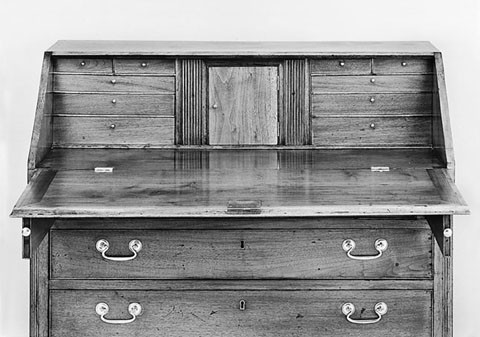
Detail of the interior of the desk illustrated in fig. 2.

Detail of the inscription on the secret drawer of the desk illustrated in fig. 2.
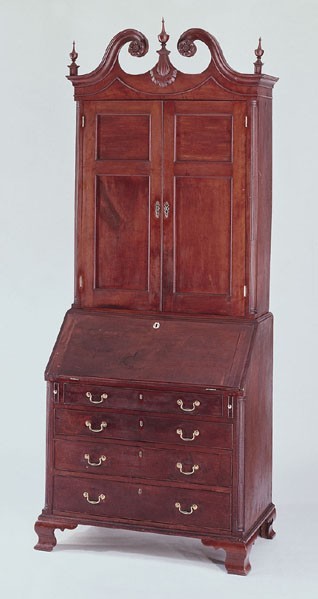
Desk-and-bookcase attributed to the Frye-Martin shops, Winchester area, Virginia, 1791–1794. Cherry with yellow pine. H. 103 3/4", W. 42 1/4", D. 24 1/2". (Courtesy, Colonial Williamsburg Foundation.) This example and the high chests illustrated in figs. 9 and 14 have their original finials and most of their original brasses.

View of the desk-and-bookcase illustrated in fig. 5 with door and fallboard open.

Detail of the interior of the desk-and-bookcase illustrated in fig. 5, showing a fluted document drawer and the prospect compartment open. The mitered molding above the door is the face of a secret drawer. A card table that descended in the Lupton family (CWF 1987-725) has a top with a molded edge of the same configuration as the molding around the prospect door.

Detail of the pediment of the desk-and-bookcase illustrated in fig. 5.
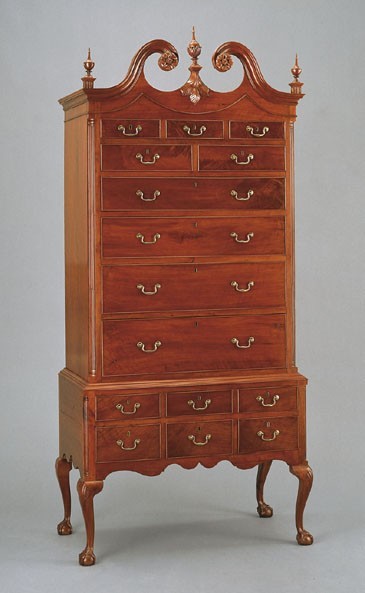
High chest with cabriole legs attributed to the Frye-Martin shops, Winchester area, Virginia, 1791–1794. Cherry with yellow pine. H. 97", W. 44", D. 24 1/4". (Courtesy, Colonial Williamsburg Foundation.)

Detail of the pediment of the high chest with cabriole legs illustrated in fig. 9.
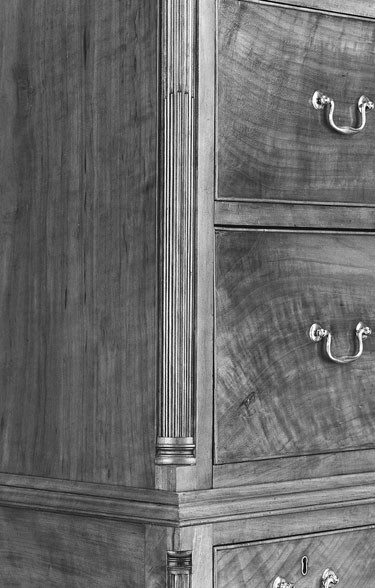
Detail of an arched, stop-fluted quarter-column on the upper section of the high chest with cabriole legs illustrated in fig. 9.
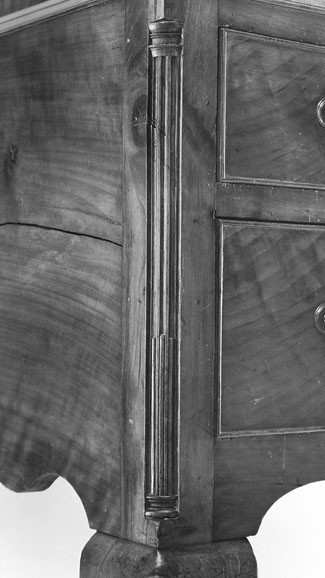
Detail of an arched, stop-fluted quarter-column on the lower section of the high chest with cabriole legs illustrated in fig. 9. This quarter-column is carved from the stile rather than being turned and fluted on a lathe like the columns on the upper section.
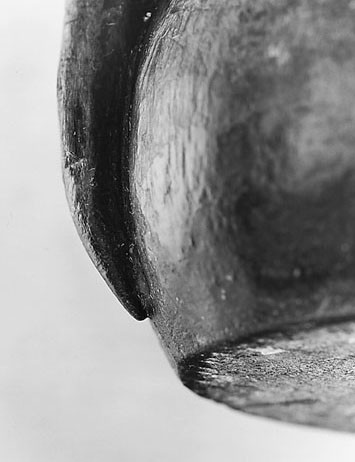
Detail of a claw-and-ball foot of the high chest with cabriole legs illustrated in fig. 9.

High chest with cabriole legs attributed to the Frye-Martin shops, Winchester area, Virginia, 1791–1794. Cherry with yellow pine. H. 97 1/2", W. 44", D. 24". (Courtesy, Colonial Williamsburg Foundation.)
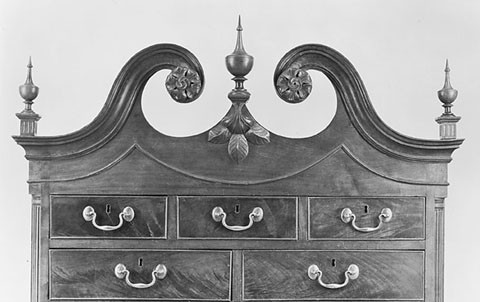
Detail of the pediment of the high chest with cabriole legs illustrated in fig. 14.
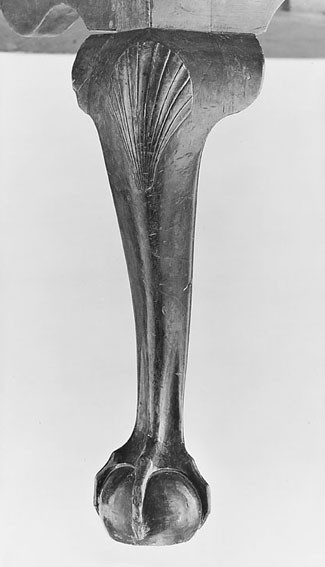
Detail of a front leg of the high chest with cabriole legs illustrated in fig. 14.
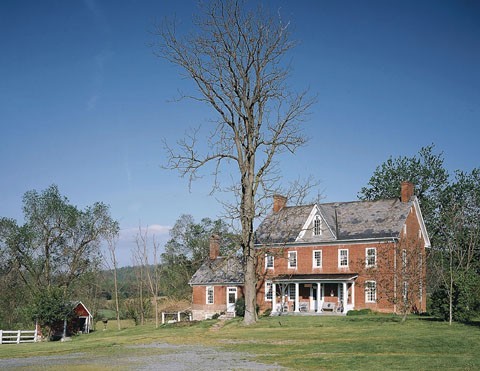
Cherry Row, Frederick County, Virginia, completed 1794. (Photo, Gavin Ashworth.)

Detail of the carved date board on the exterior of Cherry Row. (Photo, Gavin Ashworth.)
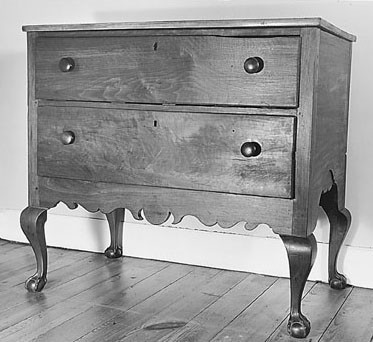
Base of a high chest with cabriole legs, Winchester area, Virginia, 1791–1794. Walnut with tulip poplar. Dimensions not recorded. (Private collection; photo, Wallace Gusler.) This base may have supported a separate case of drawers, or it may be the lower part of a single-piece form.
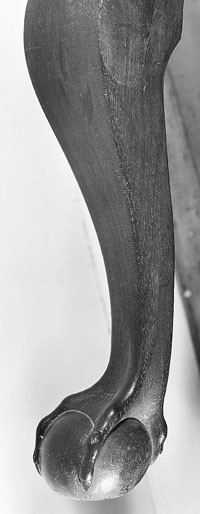
Detail of a leg of the high chest base illustrated in fig. 19.
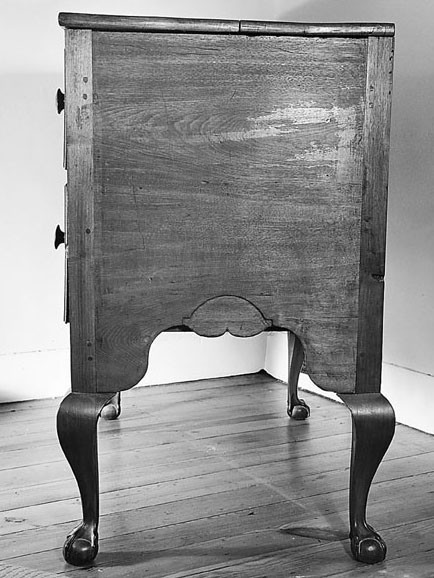
Detail of the right side of the high chest base illustrated in fig. 19.
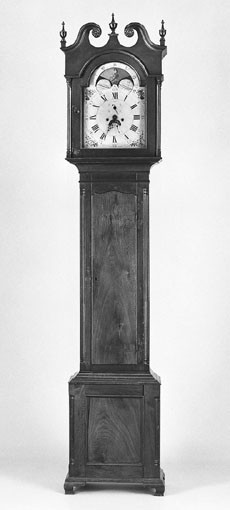
Tall clock case attributed to the Frye-Martin shops, Winchester area, Virginia, ca. 1795. Walnut with yellow pine. H. 99 1/2". (Private collection; photo, Craig McDougal.) The movement is not signed. The tips of the ogee feet are missing. The door has scars from modern, surface-mounted false hinges, but the original hinges are intact.
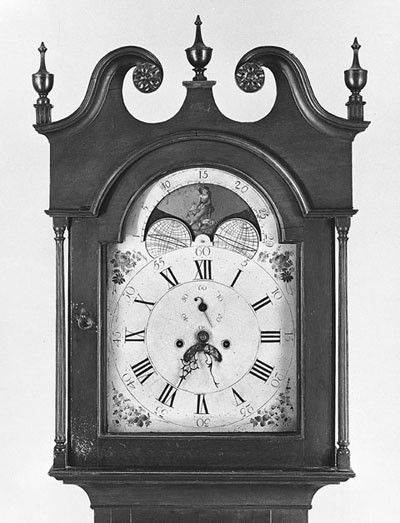
Detail of the hood of the tall clock case illustrated in fig. 22.
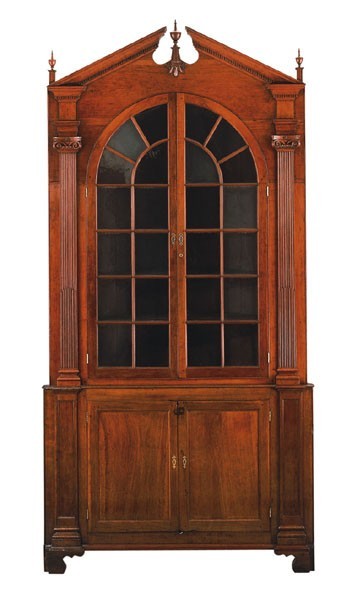
Corner cupboard attributed to the Frye-Martin shops, Winchester area, Virginia, ca. 1790. Cherry and mahogany (capitals) with yellow pine. H. 125", W. 61", D. 24". (Courtesy, Colonial Williamsburg Foundation.) The shelves are faced with applied strips with scalloped
lower edges.
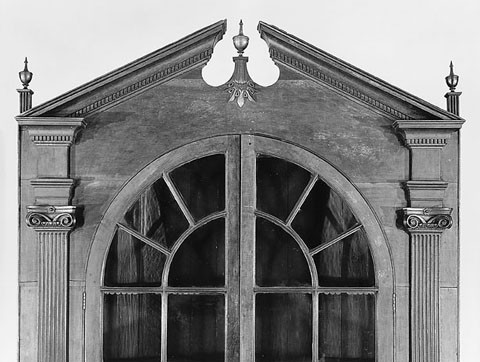
Detail of the pediment of the corner cupboard illustrated in fig. 24.
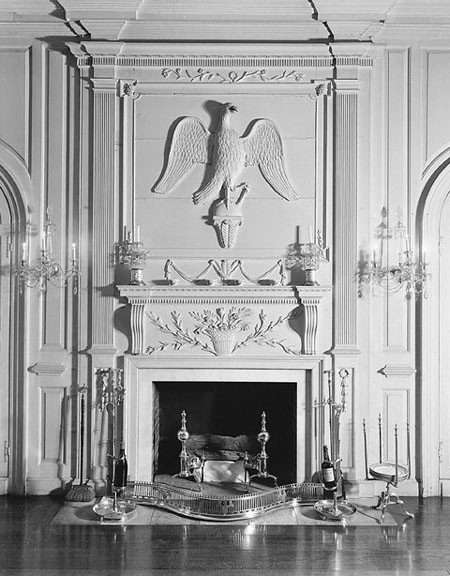
Overmantle from the James Hamilton House, Kernstown, Virginia, ca. 1800. Painted yellow pine. (Courtesy, Winterthur Museum.) The eagle has been removed from its original position shown here and reinstalled in another location in the Winterthur Museum.
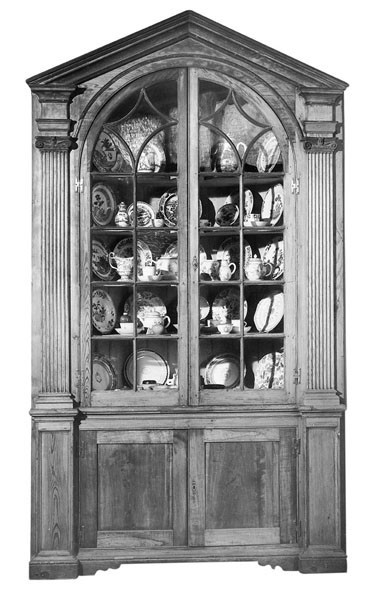
Corner cupboard, Winchester area, Virginia, ca. 1790. Yellow pine, walnut (capitals), and maple (shell) with yellow pine; linen lining; traces of original blue paint inside and out. Dimensions not recorded. (Courtesy, Piaget, St. Louis.)
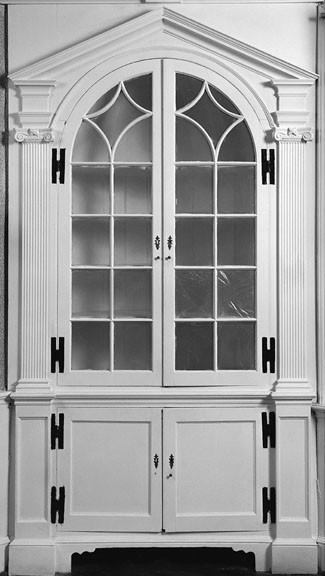
Corner cupboard in Cherry Row, Frederick County, Virginia, completed ca. 1794. Yellow pine and maple (capitals) with yellow pine; linen lining; traces of original blue paint inside and out. Dimensions not recorded. (Private collection; photo, Gavin Ashworth.)
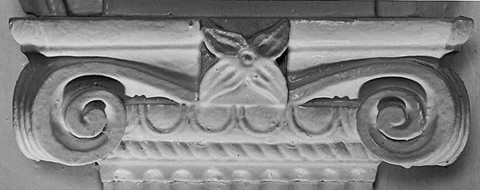
Detail of a capital on the corner cupboard illustrated in fig. 28. (Photo, Gavin Ashworth.)

Detail of a capital on the corner cupboard illustrated in fig. 27.
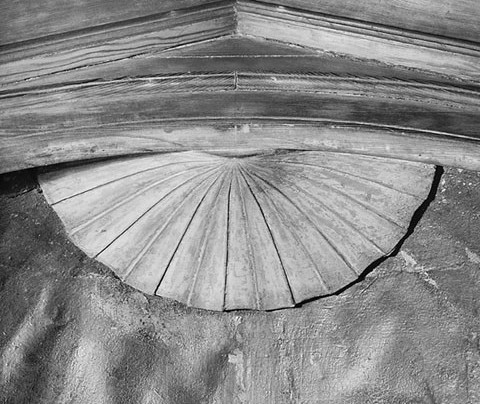
Detail of the carved shell in the interior of the corner cupboard illustrated in fig. 27.

Detail of a carved capital in Belle Grove, Frederick County, Virginia, ca. 1795. (Courtesy, Belle Grove Plantation; photo, Wallace Gusler.)

Desk-and-bookcase, Winchester area, Virginia, ca. 1800. Walnut with yellow pine.
H. 93", W. 41 1/4", D. 23". (Private collection; photo, Craig McDougal.) The feet, finial, and rosettes are restorations based on the Lupton desk-and-bookcase (fig. 5) and the tall clock case shown in fig. 22.
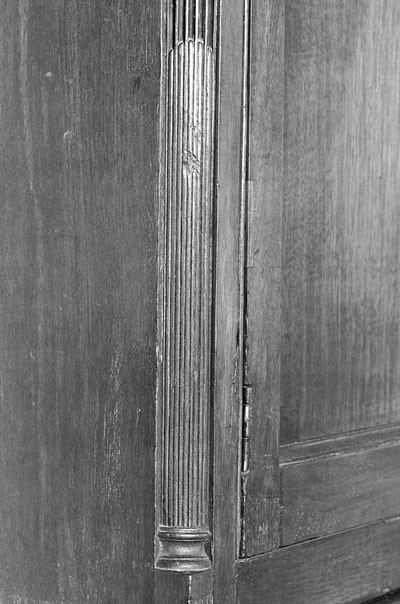
Detail of an arched, stop-fluted, quarter-column on the desk-and-bookcase illustrated in fig. 33. (Photo, Museum of Early Southern Decorative Arts.)
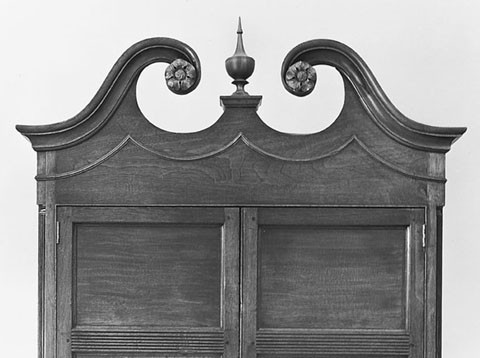
Detail of the pediment of the desk-and-bookcase illustrated in fig. 33.
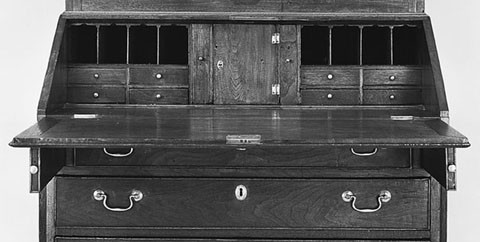
Detail of the interior of the desk-and-bookcase illustrated in fig. 33.
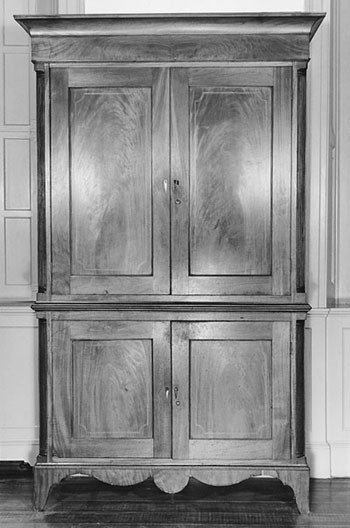
Clothespress, Winchester area, Virginia, ca. 1815. Mahogany and mahogany veneer with yellow pine. Dimensions not recorded. (Courtesy, Belle Grove Plantation.)

Detail of the capitals on the upper and lower sections of the clothespress illustrated in fig. 37.

High chest, Winchester area, Virginia, ca. 1795. Walnut with yellow pine. H. 84", W. 48", D. 23". (Private collection; photo, Wallace Gusler.) The feet are replacements.
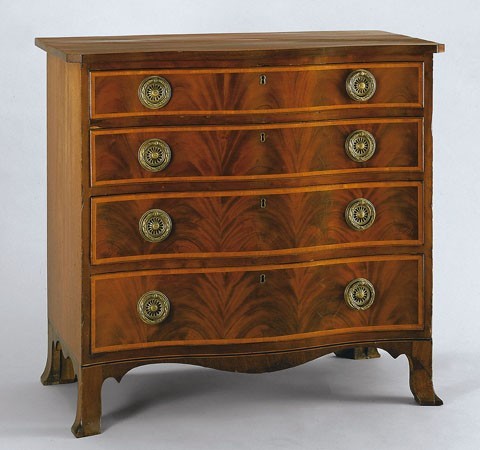
Chest of drawers, Winchester area, Virginia, ca. 1790. Mahogany, mahogany veneer, and apple with yellow pine. H. 36 1/8", W. 39", D. 20 3/4". (Private collection; photo, Craig McDougal.)
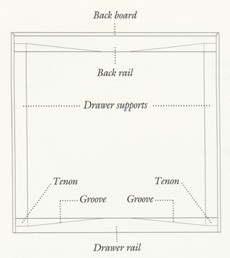
Plan of the drawer support system of the chest of drawers illustrated in fig. 40. (Drawing, Wallace Gusler; artwork, Wynne Patterson.)
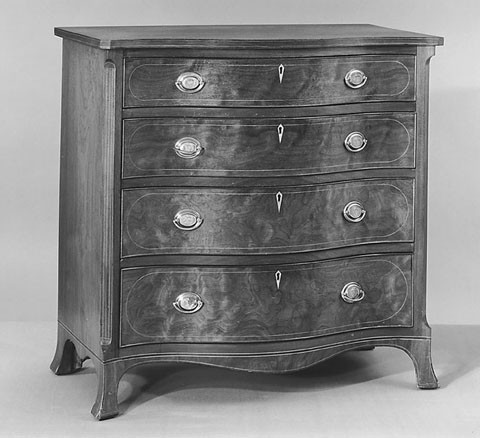
Chest of drawers, Winchester area, Virginia, ca. 1810. Walnut with yellow pine. H. 37 5/8", W. 38", D. 21 7/8". (Courtesy, Colonial Williamsburg Foundation.)
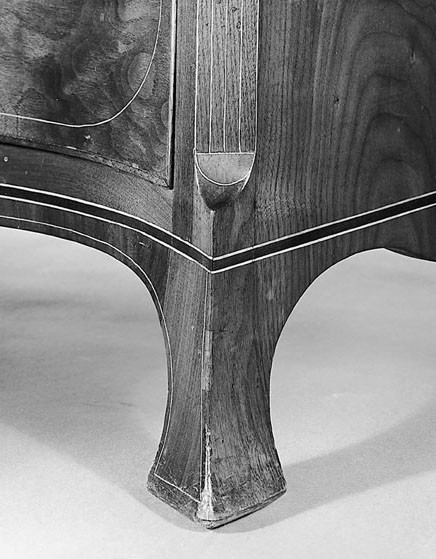
Detail of the foot of the chest of drawers illustrated in fig. 42.

Tall clock case, Winchester area, Virginia, ca. 1790. Curly maple with yellow pine and walnut. H. 87 3/4", W. 22 1/4", D. 12 1/4". (Courtesy, Colonial Williamsburg Foundation.)
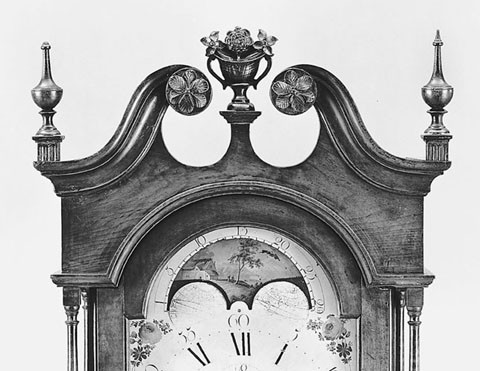
Detail of the hood of the tall clock case illustrated in fig. 44.

Detail of the brass patchbox on a rifle signed “J. Haymaker,” Winchester, Virginia, ca. 1790. Curly maple, iron, steel, brass, and silver. L. 60". (Private collection; photo, Craig McDougal.) Haymaker’s work reflects an acute understanding of the rococo style and its application to woodcarving, brass work, and engraving. From the standpoint of design and workmanship, the products of the city’s riflemaking school are far more sophisticated than those of the furniture-making school.

Desk, Winchester area, Virginia, ca. 1800. Walnut and maple inlay with yellow pine and tulip poplar. H. 44 3/8", W. 40 3/4", D. 21 3/4". (Private collection; photo, Craig McDougal.) The desk has arched, stop-fluted quarter-columns and other features associated with the Frye-Martin shops. The interior has a central prospect door flanked by four equal-sized drawers (two over two). Above the drawers are three pigeonholes with arched valances. The prospect door of the interior has the initials “I·F” inlaid in maple.
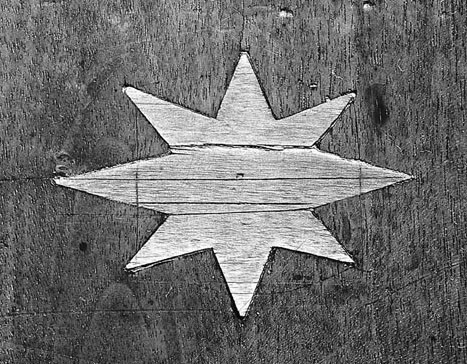
Detail of the star inlay on the fallboard of the desk illustrated in fig. 47.

Detail of the cheek rest of the rifle illustrated in fig. 46, showing the silver “hunter’s star” inlay.
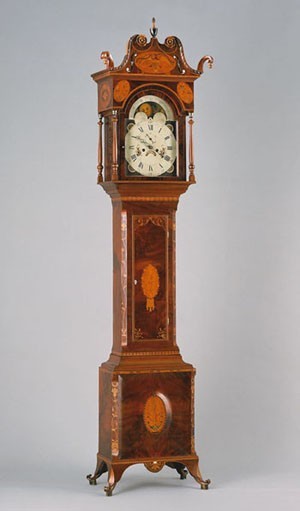
Tall clock case attributed to Peter Raff with movement attributed to Peter Whipple, Pulaski County, Virginia, ca. 1815. H. 10 8 1/2", W. 24", D. 15". (Courtesy, Colonial Williamsburg Foundation.)
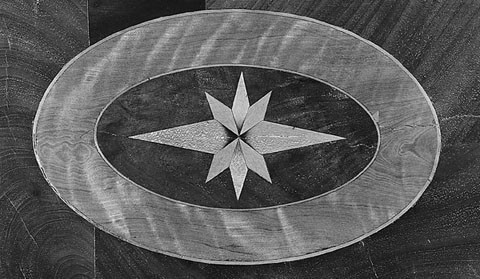
Detail of the hood of the tall clock case illustrated in figure 50.
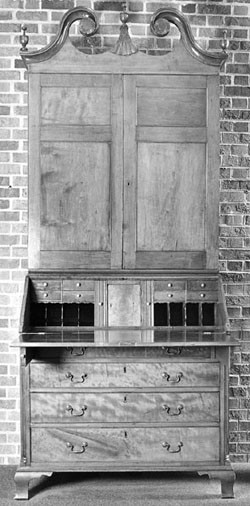
Desk-and-bookcase, Knoxville, Tennessee, ca. 1810. Cherry with yellow pine and tulip poplar. H. 96" (minus feet), W. 42", D. 20". (Courtesy, Lawson McGhee Library; photo, Museum of Early Southern Decorative Arts.)

Detail of the pediment of the desk-and-bookcase illustrated in fig. 52.
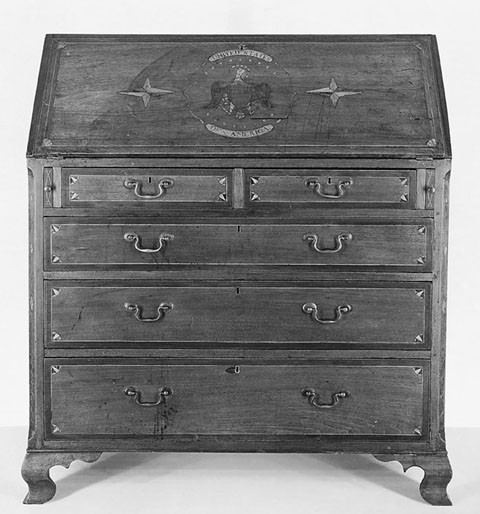
Desk, Virginia or Tennessee, 1808. Walnut and maple inlay with tulip poplar. H. 47 1/4", W. 42", D. 20". (Courtesy, Winterthur Museum.)
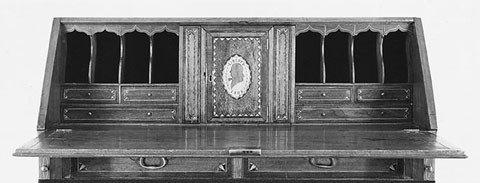
Detail of the writing compartment of the desk illustrated in fig. 54. The mitered molding above the door is the face of a secret drawer.
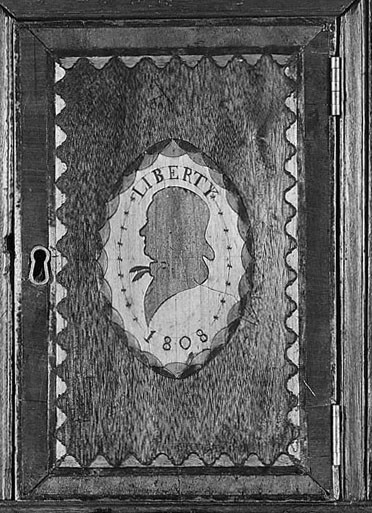
Detail of the prospect door of the desk illustrated in fig. 54.
The modern realtor’s axiom “location, location, location” certainly applied to the thriving, eighteenth-century town of Winchester, Virginia. Strategically situated on the “Great Wagon Road”—the longest and most traveled highway in colonial America—Winchester was a major center of frontier development (fig. 1). The town was also a crossroads, connected to eastern Virginia by Ashby’s Gap and to the western frontier by the Potomac River Valley and several gaps in the Allegheny Mountains. This location facilitated trade and attracted settlers from the Delaware River Valley, the piedmont and Chesapeake Bay regions of Virginia and Maryland, and other areas of the southern backcountry. By 1776, Winchester was one of the largest backcountry towns in the colonies.
The earliest European exploration of the Shenandoah Valley occurred during the late seventeenth century, when the area had few permanent inhabitants and was principally a hunting ground for Native Americans. Winchester was apparently established at the site of Shawnee Springs, an Indian village located near the warriors’ path. This path, which traversed the length of the valley and connected the “Northern” and “Southern” Indians, eventually became the “Great Wagon Road.”[1]
Popular literature credits Virginia Lieutenant Governor Alexander Spotswood’s 1716 expedition by the “Knights of the Golden Horseshoe” with the official discovery of the Shenandoah Valley, but Indian traders and explorers had penetrated the area much earlier. The northern end of the valley was mapped by Louis Michell in 1707. Spotswood was, however, instrumental in changing the land granting policies of the General Assembly to encourage settlement in western Virginia. Whereas the old “head right” system allotted fifty acres for every settler, the new system allotted fifty acres and gave individuals the option to purchase an unlimited number of fifty-acre tracts for five shillings each.[2]
During the late 1720s, settlers began to move into the northern Shenandoah Valley. Wealthy eastern Virginians also capitalized on the more liberal land granting policies by surveying and buying extensive tracts as speculative investments. In 1728, Tidewater planters Robert Carter and Mann Page purchased 50,000 acres in the Shenandoah Valley. During the following decade, Jacob Stover, Joist Hite, Robert McKay, and John and Isaac Van Meter acquired large tracts to settle German, Swiss, and Scots-Irish families.[3]
As settlement increased, the Virginia legislature made provisions for the establishment of new counties. Frederick County was established in the northern valley in 1738, and Augusta County was established in the central and southwestern valley in 1745. Orange County, Virginia, surveyor James Wood laid out the first town in the Shenandoah Valley in 1744. Originally named Frederick Town, it became the seat of Frederick County and was subsequently incorporated as Winchester.[4]
Among the earliest settlers in the valley were Germanic and Scots-Irish immigrants, most of whom were second-generation Pennsylvanians. They accounted for about two-thirds of the population prior to the Revolution. British colonists from eastern Virginia made up the remainder, along with a few settlers from other areas such as New York and Maryland. By the third quarter of the eighteenth century, the Shenandoah Valley’s population was a mosaic of diverse peoples and religions—Presbyterians, Lutherans, Anglicans, Quakers, Dunkards, and Mennonites. This diversity brought together numerous cultural lifestyles and trade traditions. Eventually these cross-currents of style and function merged British and Germanic traditions.[5]
Many objects produced in the region show the duality of these influences. Germanic craftsmen contributed strongly to the establishment of trades in Winchester and the Shenandoah Valley. Their conservative lifestyle and strong work ethic was often in sharp contrast to that of the Scots-Irish, as pointed out by an early nineteenth-century observer:
you can always tell when you get among the Dutch and the Quakers, for there you perceive that something has been done for posterity. Their houses are of stone, and built for duration, not for show. If a German builds a house, its walls are twice as thick as others—if he puts down a gate-post, it is sure to be nearly as thick as it is long. Every thing about him, animate and inanimate, partakes in this character of solidity. His wife is even a jolly, portly dame—his children chubby rogues, with legs shaped like little old-fashioned mahogany bannisters—his barns as big as fortresses—his horses like mammoths . . . his cattle enormous—It matters not to him, whether the form of sideboards or bureaus changes, or whether other people wear tight breeches or Cossac pantaloons in the shape of meal-bags. Let fashion change as it may, his low, round crowned, broad brimmed hat keeps its ground—his galligskins support the same liberal dimensions, and his old oaken chest and clothespress of curled maple, with the Anno Domini of their construction upon them, together with the dresser, glistening with pewter plates, still stand their ground, while the baseless fabrics of fashion fade away. . . . Ceaseless and unwearied industry is his delight, and enterprise and speculation his abhorrence. Riches do not corrupt, nor poverty depress him; for his mind is a sort of Pacific ocean . . . unmoved by tempests, and only intolerable from its dead and tedious calms. . . . [W]hen he dies, his son moves on in the same pace, till generations have passed away, without one of the name becoming distinguished by his exploits or his crimes.
Although this amusing characterization is obviously prejudiced, a tendency toward excessive technology and stylistic conservatism is manifest in Germanic architecture and decorative arts from the Shenandoah Valley as well as from other areas of America and Europe.[6]
The “ceaseless and unwearied industry” of the region’s Teutonic settlers undoubtedly contributed to the region’s economy, which was largely based on the cultivation and export of grain, hemp, and livestock. Wheat, corn, and cattle were marketed in Philadelphia and eastern Virginia, and hemp was exported for the manufacture of rope. The Indian trade in furs and deerskins was also important in the development of the region. The earliest white settler at Winchester was probably an Indian trader. One of the most typical patterns of settlement in the backcountry began with the establishment of an Indian trader at a critical geographic location. Eventually his trading post became a store, and a settlement or town developed around it. As the town grew, merchants and tradesmen supplied and produced goods for the frontier trade. The rapid growth of settlement in the Shenandoah Valley and western territories also provided an expanding market for the vast array of imported items required by hunters, farmers, and tradesmen.[7]
During the French and Indian War (1754–1763), Winchester was the headquarters for General Edward Braddock’s campaign against Fort Duquesne. The building of Braddock’s Road, which cut through the mountains to the west, was important to settlement after the war. The town also profited from the construction of Washington’s headquarters, Fort Loudon, just north of Winchester in 1756 and the subsequent quartering and provisioning of troops and refugees. In 1760, Andrew Burnaby noted that Winchester had about two hundred houses and was “the place of general rendezvous of the Virginia troops, which is the reason of its late rapid increase and present flourishing condition.”[8]
Later in the century, the production of cast-iron stoves, firebacks, utensils, and pig and bar stock became integral components of the regional economy. In 1767, Isaac Zane of Philadelphia purchased a “Mansion House,” a “Furnace Called Marlboro,” and several hundred acres of land about twelve miles from Winchester. Because the ore near the furnace produced pig and bar iron that was brittle and unsuitable for “American Consumption,” Zane built a new furnace near beds of more malleable ore in 1772. The following year, Zane’s common-law wife, Sally, reported that they could “not keep any Great Stock of Iron on Hand there being so many Customers ready for it almost as fast as it is made.” In 1781, Thomas Jefferson estimated that Marlboro Furnace was producing 600 tons of pig iron and 150 tons of bar iron annually.[9]
Descriptions of Winchester changed markedly during the third quarter of the eighteenth century. In 1755, English visitor Lord Adam Gordon remarked that the town was built of limestone and “inhabited by a spurious race of mortals known by the appellation of Scotch-Irish.” Twenty years later, Philip Vickers Fithian referred to it as “a smart village nearly half a mile in length, and several streets broad and pretty full. . . . The land is good, the country pleasant, the houses in general large.” Fithian also wrote that “we see many everyday, traveling out and in, to and from Carolina, some on foot with packs, and some in large covered wagons. The road here is much frequented, and for 150 miles farther [south] . . . thickly inhabited.”[10]
The pace of settlement expanded dramatically after the Revolution. As the mercantile importance of Winchester grew, the town’s society became increasingly cosmopolitan and complex. Mrs. Susanna Knox described the elegant lifestyle and cultural diversity of the town at the turn of the century.
I have already experienced more true politeness, hospitality and attention in the short time I have been here than I ever did . . . in Fredericksburg where I was bred. I went first to Dr. Mackeye, he has a handsome house elegantly furnished. I think his drawing room is one of the genteelest I ever saw. . . . Yesterday we drank tea with a Mrs. Tidbald, another most delightful woman. She was bred in Philadelphia. Her husband is a merchant of prominence, and she made the greatest display of plate at her tea table that ever I saw—a large silver tea urn, coffee pot, tea pot, cream pot, sugar cup, slop bowl, and a large silver goblet on the side table all beautifully ornamented. They live in a large stone house. I was only in the drawing room—that was a very handsome one elegantly furnished with mahogany—a settee covered with copper plate calico, red and white, the window curtains the same, with white muslin falls drawn up in festoons, with large tassels as big as my two fists. . . . Mr. Peacock has just made a purchase of a beautiful lot with a very pretty house, a number of fine fruit trees, a good garden and a well on it—and gives only 200 for it and that to be paid off in so easy a manner that it will be no more than paying rent. . . . It provokes me to think how much dearer the lots are in Falmouth, and this town is larger than Fredericksburg and it put together. I was at the Dutch church last Sunday, a very handsome stone building. . . . It has a fine steeple [and] . . . is nicely finished off within. . . . There is one of the finest organs in it I ever heard, so you may perceive that I am quite in my element. Fine society, charming music, excellent living, and no trouble about it. I wish to God all my family . . . were well settled up here. . . . I would be bound never to want to cross the Ridge again.
Although one may doubt that Winchester was as perfect as Mrs. Knox depicted it, the account of her visit is revealing. Her references to inhabitants from Baltimore and Philadelphia alluded to the cosmopolitan composition of Winchester’s “higher class.” She also acknowledged that the inhabitants were extremely hospitable and that “many of [the] . . . lower order who are entirely strangers . . . seem anxious for the welfare of my children.” Her references to the different social classes and her description of the Dutch church and the minister’s sermon “preached in English that day” are evidence of the social and cultural diversity that made Winchester a thriving town.[11]
By the end of the colonial period, Winchester was the largest town west of the Blue Ridge Mountains. The same social, cultural, and economic forces that propelled its development are embodied in the material culture of the region—particularly in the furniture made in and around Winchester during the late eighteenth and early nineteenth centuries. The cabinetmaking trade profited from the patronage of a strong middle and upper class, and a great variety of sophisticated furniture survives. The town’s diverse cultural traditions and mercantile and family connections with Philadelphia and Baltimore are reflected in both the style and construction of this material. A strong Delaware Valley influence is evident in the earliest furniture, whereas Baltimore styles influenced the inlay and veneering practices of many later neoclassical pieces.
The key to identifying early Winchester-school furniture is a desk (figs. 2-4) inscribed “Christopher Frye Cabinet Maker Fauquire August 25 1797—James Lee Martin His Shop.” The earliest reference to James Lee Martin in Fauquier County, Virginia, is the tax list for 1794. Although generally referred to as “James L. Martin,” the 1798 records list him as “James Lee Martin” and note that “Christopher Frye” was a tithable member of his household. Frye is not listed in Martin’s tax entry for the following year, but Martin did have a tithable household member named “Presley Foley.” Like Frye, Foley was probably an apprentice or journeyman in Martin’s shop.[12]
Frye was the son of Christopher Frye, Sr., of Winchester and appears as a tithable individual on his father’s tax records in 1794. The following year, the younger Frye began working in Martin’s Fauquier County shop. Christopher Frye, Sr., was probably a cabinetmaker. In his 1801 will, he directed Christopher Frye, Jr., “to look after [his] . . . business.” Christopher Frye, Sr., was listed as a farmer from Holland when he served in the Seventh Company of the Virginia Regiment in 1756; however, the fact that he had a “business” and lived in Winchester at the time of his death indicates that he was not principally a farmer in his later life. He may have learned his trade after serving in the military, or he could have been listed as a farmer because of a dual occupation. A casual approach to trade designations was common in eighteenth-century recordkeeping.[13]
The elder Frye left land to his son, Christopher, his daughter, Polly, and his son-in-law, James Lee Martin. Apprentices and journeymen frequently married into their master’s family. Perhaps this practice applies here, since Martin married Mary (Polly) Frye in Frederick County, Virginia, on May 21, 1793, the year before he moved to the shop in Fauquier County. He was probably one of the James Martins who worked in the cabinetmaking and chairmaking trades in Baltimore during the 1780s and 1790s.[14]
A desk-and-bookcase made for Frederick County farmer and entrepreneur David Lupton (figs. 5-8) shares several features with the Frye-Martin desk (fig. 2). Lupton family tradition maintains that the desk-and-bookcase and two related cabriole-leg high chests (figs. 9, 14) were made by an itinerant cabinetmaker from Baltimore. The “itinerant” aspect of the history is misunderstood, since Martin worked in the area for over twenty years; however, the physical and documentary evidence associated with these pieces suggests that this tradition is essentially correct. Lupton was also acquainted with the Frye family. In 1790, Christopher Frye, Sr., and his wife, Mary, sold Lupton a half-acre lot in Winchester.[15]
The Lupton desk-and-bookcase and the Frye-Martin desk have prospect doors with nearly identical molded surrounds and wide fluted document drawers without bases or capitals. On both desks, the molding above the prospect door is the front of a shallow drawer, and inside the prospect compartment, a small panel beneath the drawer pulls out to access a small, “secret” well. The construction of the Lupton and Frye-Martin pieces is virtually identical. The only significant difference is in the base and capital moldings of the quarter-columns. Those of the signed example are larger and less academic than the turnings on the Lupton group. The base and capital moldings on the Frye-Martin desk appear to be scaled for a full column rather than for a quarter-column, whereas those on the Lupton pieces are remarkably similar to imported brass bases and capitals commonly found on urban British and American case pieces. These differences could signify the work of two different turners in or contracted by the Frye-Martin shop; they could represent different options available to patrons; or they could reflect different approaches to the application of architectural details, one type by Frye and the other by Martin.
James Lee Martin died in 1815 at Berryville, Virginia, a few miles northeast of Winchester. His extensive inventory indicates that he was working as a cabinetmaker until his death. His wife, Mary, bought most of the household furniture, and their son Wilford purchased the majority of the woodworking tools and workbenches, presumably to carry on the cabinetmaking business. Christopher Frye, Jr., resided in Winchester at least until 1815 when he sold land.[16]
The furniture attributed to the Frye-Martin shops is part of a large school of cabinetmaking that flourished in the northern Shenandoah Valley during the late eighteenth and early nineteenth centuries. At least forty-five related pieces survive, and approximately two-thirds of these examples were found in or have histories associated with Winchester and/or Frederick County. Included in this group are high chests with cabriole legs, high chests of drawers (three drawers over two drawers over four long drawers), conventional four-drawer chests, desks, desk-and-bookcases, tall clock cases, card tables, clothespresses, and corner cupboards.[17]
Although several cabinet firms were operating in the Winchester area, the products of the Frye-Martin shops have several consistent structural and stylistic features:
1. Desk-and-bookcases, cabriole-leg high chests, and corner cupboards have upper sections that are taller in proportion to the lower sections than on most American examples (see figs. 5, 9, 14). This trait appears to have originated in the Winchester school and is found on furniture made as far south as Rockingham and Augusta Counties in the Shenandoah Valley.
2. Scroll pediments have over-arcing ends with rosettes centered lower than on comparable Philadelphia examples. The Winchester pediments are also more open because the tympanum intersects the scroll moldings at a point lower than on examples from other areas (see figs. 8, 10, 15).
3. Scroll pediments usually have an astragal molding a few inches below the crown and scroll moldings. This astragal is single- or double-swagged beneath the center scroll section (see figs. 8, 10, 15, 33). Straight astragal moldings also occur below the hoods of tall clock cases (see fig. 22) and below the cornice moldings of high chests (fig. 39).
4. The central plinths of scroll and pitch pediments often have applied carving designed in two layers—a convex shell overlapping a flaring stylized foliage (figs. 8, 10, 15, 25). On Tennessee furniture in the Winchester style, these elements are reversed (see fig. 53).
5. Neoclassic, urn-style finials are usually atop fluted plinths positioned on the corners of the crown molding, not lined up with the corners of the main case below as in more academic examples.
6. Paneled doors usually have two panels, a tall vertical rectangle and a smaller square or horizontal rectangle. This combination probably resulted from the attenuated design of the upper cases (see figs. 5, 33).
7. Quarter-columns and pilasters often have arched stop-fluting (see figs. 11, 12, 34).
8. Claw-and-ball feet have talons ending short of the bottom of the balls (see figs. 13, 16). The rear talon is shorter than the front and side talons, almost doubling the distance from the end of its talon to the floor level.
9. Desk interiors frequently have prospect doors flanked by document drawers that are unusually wide (see figs. 3, 6, 7). The faces of the document drawers are often fluted, but they do not have base and capital moldings. This stylized representation of a pilaster also has parallels in the fluting of door rails (fig. 33).
10. The full-depth dustboards are thinner than the drawer rails but do not have kickers. This dustboard design is typical of Philadelphia and probably represents an influence from that city. Backboards are nailed into rabbets in the case sides and top and to the bottom of the case.
11. Feet are usually set on flat boards that are mitered at the front corners and have the base molding cut on their projecting edge. These boards are glued and nailed to the bottom of the case. Both ogee and straight bracket feet are backed by a single, weight-bearing vertical block, and two horizontal flanker blocks support the brackets.
12. Cornices are usually nailed and glued.
13. On drawers with cockbeading, the bottoms often have two cross-grain, planed furrows cut to clear the drawer stops that are nailed and glued to the top of the drawer blades. This feature was necessary because the drawer bottom was too thick and/or not set high enough to clear the stops.[18]
14. Tall clock cases have several horizontal backboards rather than the usual single vertical board. This feature appears almost exclusively in the Frye-Martin group.
15. Clock hood doors frequently have a name written with quill and ink across the top inside of the arch. These names were written in the cabinet shop and appear to be those of the customer.
16. Yellow pine is the dominant secondary wood; occasionally poplar is used throughout, and sometimes it is combined with black walnut and yellow pine.
Because some of these features are found on furniture from other areas, they must be considered collectively or corroborated by histories or other evidence before making an attribution to a specific place, school, or shop. The furniture made for David Lupton provides an excellent case in point and serves as a springboard for examining other shop traditions that relate to and diverge from the Frye-Martin group.[19]
The desk-and-bookcase and high chests shown in figures 5, 9, and 14 were made for Lupton’s house, Cherry Row (figs. 17, 18), which is situated on Apple Pie Ridge about a mile west of Winchester. Although the high chests are very similar, they have slightly different drawer graduations, different brasses, and different finials (figs. 9, 14). Their upper cases contain four long drawers rather than three as in contemporary Philadelphia examples. The extra drawer probably accounts for the more attenuated proportions of the Winchester chests. Apparently, the design was achieved by using a standard high chest format for the upper sections. High chests made in the backcountry usually have four large drawers surmounted by two small ones.
The forward facing rear feet on these chests could reflect the maker’s lack of familiarity with Philadelphia examples, or they may have been specified by the patron. A related high chest base with correctly positioned rear feet supports the latter hypothesis (fig. 19). It has a history of descent in the Bailey, Parkins, and Solenberger families who lived south of Winchester in Shenandoah County. The feet have well defined knuckles and are among the finest produced in the Winchester area (fig. 20). The retracted talons relate to those on the Lupton chests (figs. 13, 16), but the feet of the base are clearly by a different hand. They probably represent the work of a carver rather than a cabinetmaker who occasionally did carving. The design and construction of the base is also less sophisticated than that of the Lupton chests. The maker failed to take advantage of the height of the front skirt and used linear scalloping rather than a more centralized and more conventional arched design. In addition, he cut the side scalloping above the level of the outer drawer supports and installed an inset panel to correct his mistake (fig. 21). Despite these differences, the tradesmen responsible for the base were clearly influenced by the work of the Frye-Martin shops.
The tall clock case illustrated in figure 22 has all of the structural details associated with the Frye-Martin shops. Its finials and rosettes match those on the Lupton suite (figs. 8, 10, 15, 23), and it has arched, stop-fluted quarter-columns on the waist and fluted quarter-columns on the plinth below. This quarter-column arrangement, which is relatively common in Winchester-school work, may relate to the superimposition of orders in classical architecture. The name “Anderson,” written in quill script across the inside arch of the hood door, probably refers to the original owner.
The corner cupboard illustrated in figures 24 and 25 has pilasters with arched stop-fluting, finials like those on the clock case and high chests shown in figures 8, 10, 15, and 23, and a tympanum appliqué by the same hand that carved the appliqués and rosettes on the clock case and all of the pieces in the Lupton suite. Antique dealer Joe Kindig, Jr., purchased this cupboard and the overmantle shown in figure 26 out of the James Hamilton House in Kernstown, about a mile south of Winchester. The overmantel is one of the most elaborate examples of carving from the Winchester area. The leaves and flowers rising from the basket on the overmantel are considerably more naturalistic and more skillfully rendered than the primitive foliage on furniture in the Frye-Martin group.[20]
Another corner cupboard (fig. 27) is attributed to the Frye-Martin group based on its relationship to the Hamilton example and to a built-in cupboard with a pitch pediment (fig. 28) in David Lupton’s house. Like the Hamilton cupboard (figs. 24, 25), these examples have Ionic capitals with flat arched scrolls and shallow, relatively naive egg-and-dart moldings (figs. 29, 30). On the cupboards illustrated in figures 27 and 28, the applied molding that runs over the door and joins the top molding of the capitals (figs. 27, 28) is a variation of the astragal molding found on the pediments of several other pieces in the Frye-Martin group. These cupboards are the only examples from the Winchester school with a barrel back terminated in a large, carved shell in the top (fig. 31).
Although the cupboards shown in figures 27 and 28 are principally made of yellow pine, the capitals of the former example are walnut and those of the latter are maple (figs. 29, 30). Walnut and maple take carving much better than yellow pine, which is heavily layered with hard (summer growth) and soft (spring growth) rings. On both cupboards, the contrasting woods would have been covered by their original blue paint. This wood usage is consistent with that of the Hamilton cupboard, which has cherry primary wood and mahogany capitals. Mahogany is an excellent wood for carving, but cherry tends to be brittle and splits easily. Because the colors of mahogany and cherry are compatible, they could pass for the same wood.
Another parallel to this practice is found in Belle Grove Plantation, a massive, Georgian-style stone house built by Major Isaac Hite to the south of Winchester during the 1790s. Its neoclassical woodwork is largely constructed of yellow pine, but at least one carved capital (others not examined) is either walnut or mahogany (fig. 32). Although the use of cabinet woods for carved capitals and other architectural details occurs in other areas, the corner cupboards illustrated in figures 24, 27, and 28 and Belle Grove present a strongly defined pattern. When compared with other areas of Virginia, the use of cabinetmaking woods for carved as opposed to structural components is unusual. In this instance it suggests that a cabinetmaker either from or familiar with the practices of the Frye-Martin shops was involved in the construction of Belle Grove. The parallels between the movable cupboards and the architectural example in Cherry Row (figs. 24, 27, 28) also suggest that tradesmen from the Frye-Martin shops were responsible for many of the architectural details in Lupton’s house.
The Frye-Martin shops had a tremendous influence on furniture made inthe Shenandoah Valley and as far west as Nashville, Tennessee. In some instances it is difficult to separate the products of the principal shops from those operated by journeymen and apprentices. A desk-and-bookcase with a Greene County, Virginia, history (fig. 33) is closely related to the Lupton example (fig. 5). It has arched, stop-fluted quarter-columns on both sections of the case (fig. 34) and a double-swagged, astragal molding (fig. 35) similar to the one on the tympanum of the Lupton desk-and-bookcase (fig. 8). The interior is plain but distinguished in having fine cockbeads on the partitions around the drawers and pigeonhole valances made from a single piece of wood that crosses all of the apertures on each side (fig. 36). The interior drawers have nailed frames rather than dovetailed ones like desks documented and attributed to the Frye-Martin shops. Other structural variations suggest that this desk-and-bookcase represents the work of a journeyman associated with the Frye-Martin shops. Rather than having conventional dustboards like the signed Frye-Martin desk and Lupton pieces, the desk-and-bookcase has dustboards that are set in grooves in the drawer rails and drawer supports.
As the preceding desk-and-bookcase suggests, the Frye-Martin shops appear to have been the genesis for many of the stylistic and structural details associated with the Winchester school. A clothespress with a history of ownership at Belle Grove shows how certain mainstream details, such as arched, stop-fluted quarter-columns, were reinterpreted by the tradesmen in the Frye-Martin shops and by other artisans in the Winchester school (fig. 37). The quarter-columns below the waist molding are carved with stops, and those above are carved with flutes (fig. 38). The waist molding serves as the termination of the stops when the corners are viewed as a single column; however, the capital of the stopped section and the base of the fluted section partially contradict this perception.
High chests were among the most common forms produced by cabinetmakers in the Winchester school. Most of these chests have ogee feet and conventional drawer arrangements—three small drawers over two small drawers over four large drawers—and some examples are virtually indistinguishable from high chests made in Pennsylvania, western Maryland, and other regions of the southern backcountry. The high chest illustrated in figure 39, however, has several distinctive features. The patron probably specified the six upper drawers and cornice drawer (the front of the cornice is the front of the drawer). Late seventeenth- and early eighteenth-century high chests occasionally have cornice drawers. By contrast, the arched stop-fluting and astragal molding under the cornice are typical Winchester-school details.
A serpentine chest that reportedly came from “Rockville,” the Hite family home in Frederick County (destroyed during the twentieth century), has several construction details commonly found on case pieces from the northern Shenandoah Valley (fig. 40). Instead of having dustboards, the chest has a framed drawer support system: The drawer supports are dadoed to the case sides and tenoned to the drawer dividers and to horizontal back rails (fig. 41). Most Winchester-school tradesmen used a groove plane to cut the mortises for the tenons of the drawer supports. Rather than run the groove the full length of the drawer dividers, these artisans typically left a blank or very shallow section in the middle and cut the groove full-depth at the ends alone.
The basic design of this chest is derived from rococo examples, which have the sides and middle of the serpentine on the same frontal plane. On most neoclassical chests, however, the center of the serpentine curve projects well beyond the sides (fig. 42). The drawer construction of the Hite chest also has earlier precedents. The fronts are composed of horizontally grained, vertically laminated, yellow pine planks. After gluing up the fronts, the cabinetmaker sawed them into serpentine shapes, just as he would have for a solid drawer front. By contrast, the serpentine drawer front of the neoclassical period is typically composed of many strips of wood that were sawn to a serpentine shape before being stacked and glued together. The frontal serpentine plane and drawer construction of the Hite chest suggest that it dates from the late 1780s or early 1790s and that its maker trained or worked earlier in the century.
With their straight outer edge and sharp curve at the bottom, the feet of the Hite chest are similar to those on furniture from the Shenandoah Valley and Tennessee. The early features of the Hite chest and related pieces from Frederick County suggest that this foot pattern originated in the Winchester vicinity. The use of unconventional hardwoods for contrasting veneers is also characteristic of the Winchester school. The Hite chest has apple wood cross-banding, but other pieces with ash and buckeye are known. On the most expensive examples, these local woods are often used in conjunction with imported mahogany veneer.
The chest illustrated in figure 42 is a more typical neoclassical example from the Winchester school. Its drawer fronts are veneered with curly walnut, and all of its secondary wood is yellow pine. The chest has drawer bottoms that are planed to clear the drawer stops, like those on case pieces in the Frye-Martin group, and flared, hoof-like feet similar to those on other chests from the Winchester area (fig. 43).
The stylistic influences that affected the Winchester school came from both outside and within the region. Occasionally the influence of local gunmakers is evident in Winchester furniture. The curly maple tall clock case illustrated in figures 44 and 45 has a basket ornament with spiraled, four-petal flowers that are remarkably similar to those on the capitals of the Lupton cupboard (fig. 29) and on the floral finial of the brass patchbox (also engraved near the door hinge) of a rifle signed by John Haymaker (d. 1804) of Winchester (fig. 46). Haymaker also carved the same flower on the forestock; however, the carving is extremely worn. Dozens of Shenandoah Valley riflemakers used this finial and carved detail, indicating that the motif was popular throughout the region. The rifle stock, clock ornament, and capitals are also related in being made of curly maple, the standard wood used by Shenandoah Valley riflemakers. Associated style and technology linked the riflemaking, cabinetmaking, and house joinery trades. Artisans in backcountry towns, particularly those of Germanic descent, often maintained close ties. John Haymaker, for example, witnessed Christopher Frye, Sr.’s, will.[21]
A different association between the gunmaking and cabinetmaking trades is evident in the career of riflemaker George Krepps (fl. ca. 1790–1820). He began his career in or near Winchester, moved to Hagerstown, Maryland, during the 1790s, and returned to Winchester by 1820, when he advertised as a cabinetmaker. Although none of his furniture has been identified, several finely carved and engraved rifles survive from his Maryland period.[22]
Like the preceding tall clock case, the desk illustrated in figure 47 has details borrowed from long rifle design. It is related to the Frye-Martin group, and its history in Upperville in Fauquier County supports that association. The stars on the fallboard (fig. 48) are elongated and have distended points like the stars on long rifles (fig. 49). Stars of this basic form originated in German rifle decoration of the seventeenth and eighteenth centuries. They are usually inlaid on the cheek rest and made of variegated horn, with each point composed of half-white and half-black segments. Although not a part of the Winchester school, a remarkable tall clock case from Pulaski County in southwestern Virginia has a star similar to the ones on the desk (figs. 50, 51). This clock shows the influence of rifle, powder horn, and musical instrument making in its design and materials. The maker of its brass movement, Peter Whipple, was probably a member of the John Whipple family of Winchester. John was working in the shop of Winchester clockmaker Goldsmith Chandlee in 1787.[23]
Winchester influences clearly extended far beyond the town. Furniture with Winchester structural and stylistic details was produced in western Maryland, Shenandoah and Washington Counies, Virginia, Monroe County, West Virginia, and Middle and East Tennessee. The distribution of this furniture shows the same basic patterns documented for the movement of Winchester riflemakers. Jacob Gabott apprenticed to Christopher Heskill in Winchester in 1758. At the beginning of the Revolution, he was part owner of a gun factory at Staunton in Augusta County, Virginia. During the 1790s, apprentices and journeymen from Simon Lauck’s shop in Winchester set up shops in other areas: John Sheets moved to Staunton, Jacob Funk and Henry Harding moved to Strasburg in Shenandoah County, and Nicholas Chisler moved to Morgantown, (West) Virginia. Winchester riflemakers and cabinetmakers moved down the Great Wagon Road to markets in the southwest or up the Potomac River Valley along the old Braddock Road and west into the Ohio Valley, following the general migration routes for the settlement of the frontier. In 1809, John Eastely (b. 1786) of Tennessee wrote Newmarket, Virginia, riflemaker Henry Spitzer:
Sir I am still calculating to come and work with you During the next winter Season . . . if you employ me and will give me any Kind of a living chance which I do not in the least doubt that you will I do not calculate on gain my principle motive in comming will be to reside where information of every Kind necessary can be had.
Apparently Eastely had worked for Spitzer before; however, his desire “to reside where information of every Kind necessary can be had” suggests that the inhabitants of the frontier considered Shenandoah Valley towns such as New Market and Winchester to be cultural, stylistic, and technological centers.[24]
Winchester influences are apparent in a large group of furniture made in the Nashville and Knoxville areas of Tennessee. A high chest of drawers and two desk-and-bookcases (figs. 52, 53) from the Knoxville area appear to be the work of a cabinetmaker trained in the vicinity of Winchester. Furniture historians Derita Coleman Williams and Nathan Harsh have attributed all of these examples to Thomas Hope, largely on the basis of family traditions. Hope was principally a house joiner. He was working in Knox County by 1797 and is thought to be the Thomas Hope listed in the Charleston, South Carolina, directory of 1790. If these objects are from Hope’s shop, he must have employed a journeyman from Frederick or Shenandoah County, Virginia. The construction and carving of these examples are clearly related to furniture from the Frye-Martin shop tradition. William Wright, who is documented in the Knoxville area in 1798, is a possible candidate for this Tennessee work. A cabinetmaker by the same name worked in Shenandoah County, Virginia, from 1790 to 1825. The Knoxville cabinetmaker may have been a member of the same family. The other Knoxville desk-and-bookcase (not illustrated) has a vertically fluted finial that is identical to many Shenandoah County examples.[25]
Similarly, Samuel Williams may have introduced Winchester styles to the Nashville area. An individual by that name appears in the 1815 settlement of James Lee Martin’s estate: “to Samuel Williams Journeyman’s acct . . . $133.00.” On June 10, 1817, a Samuel Williams in Nashville advertised that he had “lately arrived from the eastern States and is in possession of the newest fashions.” Although Williams sold his Nashville shop in 1818, he probably continued working as a journeyman there just as he had in Virginia. If these references are to the same Samuel Williams, the Nashville pieces related to the Frye-Martin group may represent his work or influence.[26]
The desk shown in figure 54 illustrates the difficulty of identifying the precise origins for some objects related to the Winchester school but made in areas far removed from the town. Like many desks associated with the Frye-Martin group, it has wide document drawers, a prospect door with a molded surround concealing a “secret” drawer (figs. 55, 56), and a hidden well beneath the drawer inside the prospect. Its pigeonhole valances are constructed in single units that cross all four openings on each side, like those on the Winchester desk-and-bookcase illustrated in figures 33 and 36. The extensive inlay on this desk represents a departure from Winchester work, with the exception of the stars on the fallboard. The placement of the stars is remarkably similar to that of the Winchester desk shown in figure 47. The distance between the stars on the Winchester example is more understandable when compared with the fallboard inlay on the other desk, which centers around an eagle (fig. 54).
The case construction of the preceding desk is more primitive than that usually found in Winchester work. The drawer rails and supports, for example, are lapped onto the drawer rails and nailed to the sides of the case. The fan inlays on the drawer fronts and scalloping on the edges of the prospect door are associated with East Tennessee work. Inlaid profiles also occur on an East Tennessee chest (not illustrated) with feet that are virtually identical to those on the Hite example (fig. 40). Although these decorative features are relatively common in East Tennessee furniture, similar details are found on pieces from the lower Shenandoah Valley, particularly from the area between Augusta and Washington County bordering on Tennessee. The desk was purchased in Wythe County, Virginia, but it does not have a family history to help substantiate its origin.[27]
The 1808 date and nationalistic references on the desk refer to the year when James Madison of Virginia defeated Charles Cotesworth Pinckney of South Carolina in the presidential election, thus continuing the “Virginia Dynasty.” Although the features of the profile are not distinctive enough to identify the subject with any degree of certainty, it probably represents James Madison (fig. 56). The seventeen stars on the fallboard over the eagle and those on the prospect door represent the seventeen states of the Union in 1808. Regardless of whether the desk originated in southwestern Virginia or in East Tennessee, it remains important as an election year icon and as an example of the dissemination of Winchester style.[28]
The furniture and tradesmen of Winchester had a wide sphere of influence during the late eighteenth and early nineteenth centuries. Winchester was an important backcountry commercial and style center. The town’s cabinetmakers produced furniture for local demand and trained apprentices and journeymen who carried Winchester style and technology to new markets in the Shenandoah Valley and western frontier. The influence of these transplanted artisans was far more profound than the written record suggests. Like their contemporaries in Winchester, they rarely mentioned their training and tended to advertise that they employed workmen from Philadelphia, Baltimore, Norfolk, and New York. These cities were considered the leading style centers during the early federal period, as was London during the colonial period. Although Philadelphia and Baltimore influences were important in the development of the Winchester school, new styles were invariably adapted and reinterpreted to suit local cabinetmaking traditions and tastes. Whether made in the northern Shenandoah Valley, southwest Virginia, or East Tennessee, Winchester-school furniture bears the clear imprint of that city’s diverse culture and cabinetmaking traditions.[29]
ACKNOWLEDGMENTS
For assistance with this article, the author thanks Bill and Hazel Adams, Richard Adams, Georgia Allen, Mark Anderson, Luke Beckerdite, Stewart Bell, John Bivins, Laurie Bonbright, Mrs. Allen Bond, Margaret Gill, Liza Gusler, Mack Headley, Tim Hodges, Diane Hudgins, Charles Hummel, Ronald Hurst, Roger and Mary Lou Koontz, Craig McDougal, Jim and Marilyn Melchor, Roderick Moore, Fred Painter, Jonathan Prown, and Byron Smith. I am especially grateful to Betty Stvan for her assistance with numerous details pertaining to this article and to the Reverend William Hill Brown, III, for making his desk available for this study.
The Virginia Magazine 77 (1969): 291–306. John Bivins, Jr., “Isaac Zane and the Products of Marlboro Furnace,” Journal of Early Southern Decorative Arts 11, no. 1 (May 1985): 20–23.
Fauquier County Personal Property Tax Records, 1799, VSL. The case of this desk is constructed with hidden dovetails at the top and bottom. These were originally covered at the top by a bookcase (small nail holes from the waist molding are visible.) At the bottom, the hidden dovetail is covered by the base frame. The base frame is approximately 3 1/2" wide and 1" thick. It is mitered at the front corners and continues to the back on the sides. Along the back, two frame elements butt to the sides and do not extend across the back, being only long enough to support the rear foot brackets. These frame elements are made of walnut and have the base molding cut on their outer edges. The case has walnut drawer rails that are notched at the corners to receive the quarter-columns (the columns cover the rail joints) and full- to 3/4-depth dustboards that are dadoed to the sides and tongue and grooved into the rails. The dustboards are flush with the drawer rails on the top and slightly thinner at the bottom. The dadoes for the dustboards are approximately 1/4" narrower than the rails. Drawer guides are glued on top of the dustboards at each side behind the quarter-columns. The vertical back boards are nailed into rabbets at the top and sides and face nailed to the bottom of the case. The fall board support partitions are blind-mortised into the bottom of the writing surface, and are though-tenoned into the drawer rail. The walnut supports for the fall board are faced with vertically grained walnut and edged with applied cock beading. The large case drawers also have walnut fronts and applied cock beading. The drawer sides have wide dovetails and pins. The top three drawers have three tails in front and two in back, whereas the bottom drawer has four front tails and three back tails. The drawer sides and front are grooved to receive the chamfered edges of the bottoms. The bottom boards run parallel to the sides of the drawer and extend past the drawer backs. The center section of the extended bottom is cut away to the edge of the drawer back leaving the sides extended to stop against the back boards. The bottoms are nailed along the back edges. The fallboard has battens that are mitered at the top on both sides. The interior drawer bottoms are set into rabbets in the front and sides, overlap the back, and are nailed with small wrought sprigs. The bottoms are flush with the back and have small blocks glued to them to serve as drawer stops.
The desk has had at least one campaign of restoration in which most of the
original nails were lost and some repairs were made. Several pieces of wood
in the dustboards and drawer bottoms have nail holes that are not related
to the construction of the desk. Several of these appear to be in elements
of the first construction and must represent the use of salvaged wood by
Frye and Martin. The only conjectural restoration is the feet.
In this article, I use “Frye-Martin shops” and “Frye-Martin group” to designate the products of the multigenerational shop tradition that included the Fryes, Martin, and their journeymen.
The desk-and-bookcase shown in figures 33–36 has interior drawers with nailed frames, indicating that a wide range of work existed in the Winchester area and that attributions based on such variations can be tenuous. For the Tennessee chest, see Williams and Harsh, The Art and Mystery of Tennessee Furniture, p. 88, pl. 24. Wallace Gusler interview with Joe Kindig, Jr., 1970. Mr. Kindig stated that he purchased the desk illustrated in figure 54 from Wytheville, Virginia, antique dealer Garland Stevens.
